Influence of Impregnation Medium on the Adsorptive Performance of Silica Sulfuric Acid for the Removal of Gaseous o-Xylene: Comparison on Ethyl Acetate and Water
Abstract
:1. Introduction
2. Results
2.1. Loading Amount and Anchoring States of Sulfuric Acid in the SSA(E)-x and SSA(W)-x
2.2. Characterization of the Materials
2.3. Effect of Temperature on Adsorption of SSA(E)-4 and SSA(W)-4 for o-Xylene
2.4. Effect of H2SO4 Loading Amount on Adsorption of SSA(E) and SSA(W) for o-Xylene
2.5. Reusability of the Spent Supports
3. Materials and Methods
3.1. Materials
3.2. Preparation Procedure of SSA
3.3. Characterization
3.4. Dynamic Adsorption Tests
3.5. Desorption/Regeneration Experiments
4. Conclusions
Author Contributions
Funding
Data Availability Statement
Conflicts of Interest
References
- Sonar, S.; Giraudon, J.M.; Veerapandian, S.K.P.; Lamonier, J.F.; Morent, R.; Lofberg, A.; De Geyter, N. Adsorption followed by plasma assisted catalytic conversion of toluene into CO2 on hopcalite in an air stream. Catalysts 2021, 11, 845. [Google Scholar] [CrossRef]
- Sui, H.; Liu, H.; An, P.; He, L.; Li, X.; Cong, S. Application of silica gel in removing high concentrations toluene vapor by adsorption and desorption process. J. Taiwan Inst. Chem. Eng. 2017, 74, 218–224. [Google Scholar] [CrossRef]
- Bernstein, J.A.; Alexis, N.; Bacchus, H.; Bernstein, I.L.; Fritz, P.; Horner, E.; Li, N.; Mason, S.; Nel, A.; Oullette, J.; et al. The health effects of non-industrial indoor air pollution. J. Allergy Clin. Immunol. 2008, 121, 585–591. [Google Scholar] [CrossRef] [PubMed]
- Saldarriaga, J.F.; Aguado, R.; Morales, G.E. Assessment of VOC emissions from municipal solid waste composting. Environ. Eng. Sci. 2014, 31, 300–307. [Google Scholar] [CrossRef]
- Feron, V.J.; Til, H.P.; De Vrijer, F.; Van Bladeren, P.J. Review: Toxicology of volatile organic compounds in indoor air and strategy for further research. Indoor. Built Environ. 1992, 1, 69–81. [Google Scholar] [CrossRef]
- Huang, H.; Xu, Y.; Feng, Q.; Leung, D.Y.C. Low temperature catalytic oxidation of volatile organic compounds: A review. Catal. Sci. Technol. 2015, 5, 2649–2669. [Google Scholar] [CrossRef]
- Rochard, G.; Olivet, L.; Tannous, M.; Poupin, C.; Siffert, S.; Cousin, R. Recent advances in the catalytic treatment of volatile organic compounds: A review based on the mixture effect. Catalysts 2021, 11, 1218. [Google Scholar] [CrossRef]
- Veerapandian, S.K.P.; De Geyter, N.; Giraudon, J.M.; Lamonier, J.F.; Morent, R. The use of zeolites for VOCs abatement by combining non-thermal plasma, adsorption, and/or catalysis: A review. Catalysts 2019, 9, 98. [Google Scholar] [CrossRef] [Green Version]
- Kim, H.S.; Kim, H.J.; Kim, J.H.; Kim, J.H.; Kang, S.H.; Ryu, J.H.; Park, N.K.; Yun, D.S.; Bae, J.W. Noble-metal-based catalytic oxidation technology trends for volatile organic compound (VOC) removal. Catalysts 2022, 12, 63. [Google Scholar] [CrossRef]
- Zhang, X.; Gao, B.; Creamer, A.E.; Cao, C.; Li, Y. Adsorption of VOCs onto engineered carbon materials: A review. J. Hazard. Mater. 2017, 338, 102–123. [Google Scholar] [CrossRef]
- Wu, Y.; Lu, Y.; Song, C.; Ma, Z.; Xing, S.; Gao, Y. A novel redox-precipitation method for the preparation of α-MnO2 with a high surface Mn4+ concentration and its activity toward complete catalytic oxidation of o-xylene. Catal. Today 2013, 201, 32–39. [Google Scholar] [CrossRef]
- Ma, Z.; Zhu, L.; Lu, X.; Xing, S.; Wu, Y.; Gao, Y. Catalytic ozonation of p-nitrophenol over mesoporous Mn–Co–Fe oxide. Sep. Purif. Technol. 2014, 133, 357–364. [Google Scholar] [CrossRef]
- Wu, Y.; Feng, R.; Song, C.; Xing, S.; Gao, Y.; Ma, Z. Effect of reducing agent on the structure and activity of manganese oxide octahedral molecular sieve (OMS-2) in catalytic combustion of o-xylene. Catal. Today 2017, 281, 500–506. [Google Scholar] [CrossRef]
- Zhu, L.; Shen, D.; Luo, K.H. A critical review on VOCs adsorption by different porous materials: Species, mechanisms and modification methods. J. Hazard. Mater. 2020, 389, 122102. [Google Scholar] [CrossRef]
- Dammak, N.; Fakhfakh, N.; Fourmentin, S.; Benzina, M. Treatment of gas containing hydrophobic VOCs by adsorption process on raw and intercalated clays. Res. Chem. Intermed. 2014, 41, 5475–5493. [Google Scholar] [CrossRef]
- Ambrożek, B.; Zwarycz-Makles, K. Theoretical and experimental studies of the recovery of volatile organic compounds from waste air streams in the thermal swing adsorption system with closed-loop regeneration of adsorbent. Energ. Convers. Manag. 2014, 85, 646–654. [Google Scholar] [CrossRef]
- Ramalingam, S.G.; Pre, P.; Giraudet, S.; Le Coq, L.; Le Cloirec, P.; Baudouin, O.; Dechelotte, S. Different families of volatile organic compounds pollution control by microporous carbons in temperature swing adsorption processes. J. Hazard. Mater. 2012, 221, 242–247. [Google Scholar] [CrossRef]
- Swetha, G.; Gopi, T.; Chandra, S.S.; Ramakrishna, C.; Saini, B.; Rao, P.V.L. Combination of adsorption followed by ozone oxidation with pressure swing adsorption technology for the removal of VOCs from contaminated air streams. Chem. Eng. Res. Des. 2017, 117, 725–732. [Google Scholar] [CrossRef]
- Meng, Z.; Liu, Y.; Li, X.; Ma, Z. Removal of siloxane (L2) from biogas using methyl-functionalised silica gel as adsorbent. Chem. Eng. J. 2020, 389, 124440. [Google Scholar] [CrossRef]
- Pak, S.H.; Jeon, M.J.; Jeon, Y.W. Study of sulfuric acid treatment of activated carbon used to enhance mixed VOC removal. Int. Biodeter. Biodegr. 2016, 113, 195–200. [Google Scholar] [CrossRef]
- Dong, Y.; Liu, Y.; Wang, J.; Gao, K.; Ma, Z. Silica supported sulfuric acid for the removal of gaseous o-xylene. J. Environ. Chem. Eng. 2019, 7, 102992. [Google Scholar] [CrossRef]
- Ma, M.; Gao, K.; Ma, Z.; Ding, J. Influence of preparation method on the adsorptive performance of silica sulfuric acid for the removal of gaseous o-xylene. Sep. Purif. Technol. 2021, 265, 118484. [Google Scholar] [CrossRef]
- Gao, K.; Ma, M.; Liu, Y.; Ma, Z. A comparative study of the removal of o-xylene from gas streams using mesoporous silicas and their silica supported sulfuric acids. J. Hazard. Mater. 2021, 409, 124965. [Google Scholar] [CrossRef] [PubMed]
- Mollasalehi, H.; Yazdanparast, R. Non-crosslinking gold nanoprobes for detection of nucleic acid sequence-based amplification products. Anal. Biochem. 2012, 425, 91–95. [Google Scholar] [CrossRef] [PubMed]
- Bi, L.; Chen, Z.; Li, L.; Kang, J.; Zhao, S.; Wang, B.; Yan, P.; Li, Y.; Zhang, X.; Shen, J. Selective adsorption and enhanced photodegradation of diclofenac in water by molecularly imprinted TiO2. J. Hazard. Mater. 2021, 407, 124759. [Google Scholar] [CrossRef] [PubMed]
- Fakhfakh, N.; Dammak, N.; Benzina, M. Breakthrough modeling and experimental design for o-xylene dynamic adsorption onto clay material. Environ. Sci. Pollut. Res. 2018, 25, 18263–18277. [Google Scholar] [CrossRef] [PubMed]
- Ma, M.; Gao, K.; Zhao, D.; Ma, X.; Ma, Z. Effect of process conditions on reaction-type adsorption of o-xylene by MCM-41 supported sulfuric acid: Model simulations of breakthrough curves. J. Environ. Chem. Eng. 2022, 10, 106937. [Google Scholar] [CrossRef]
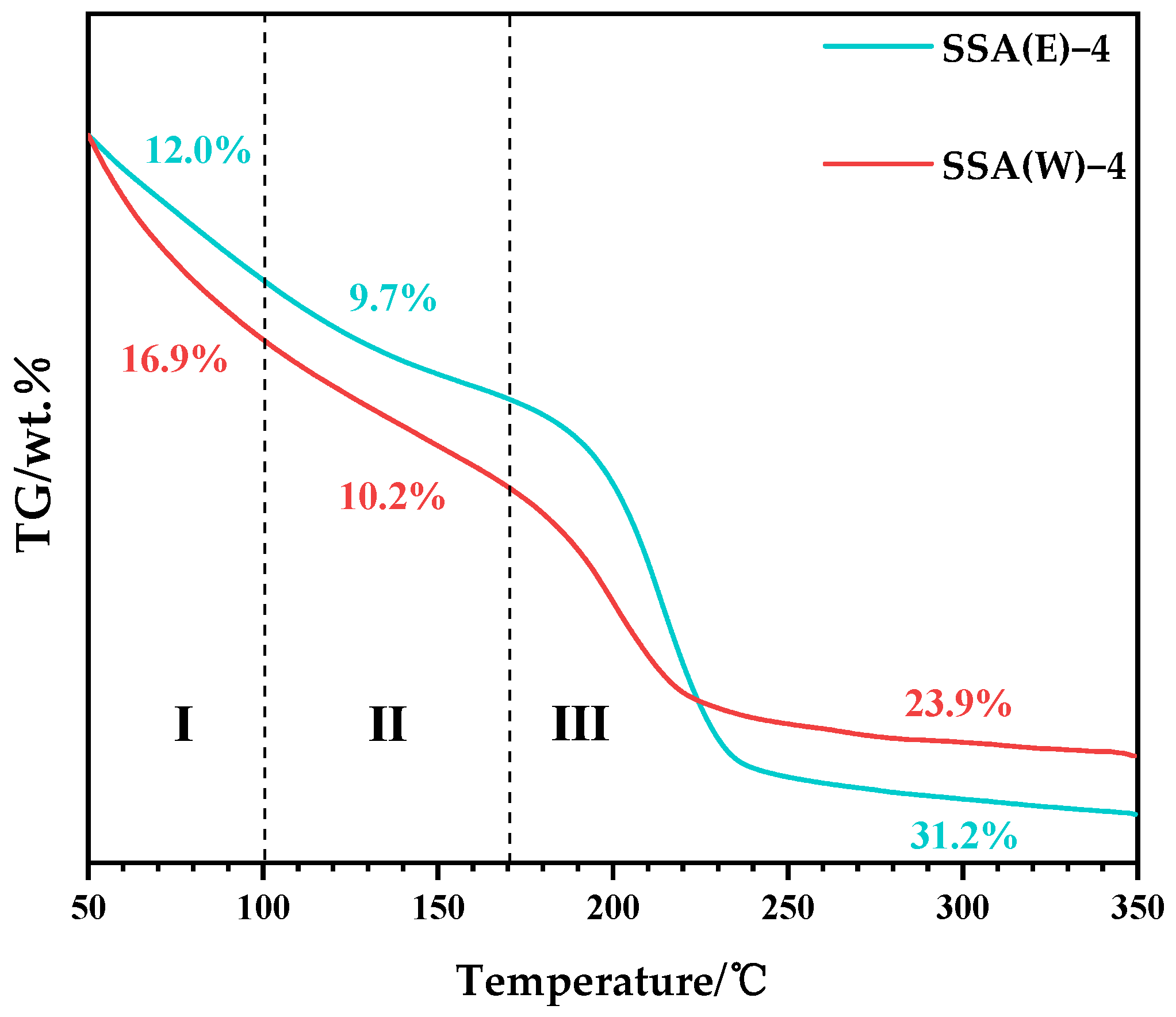
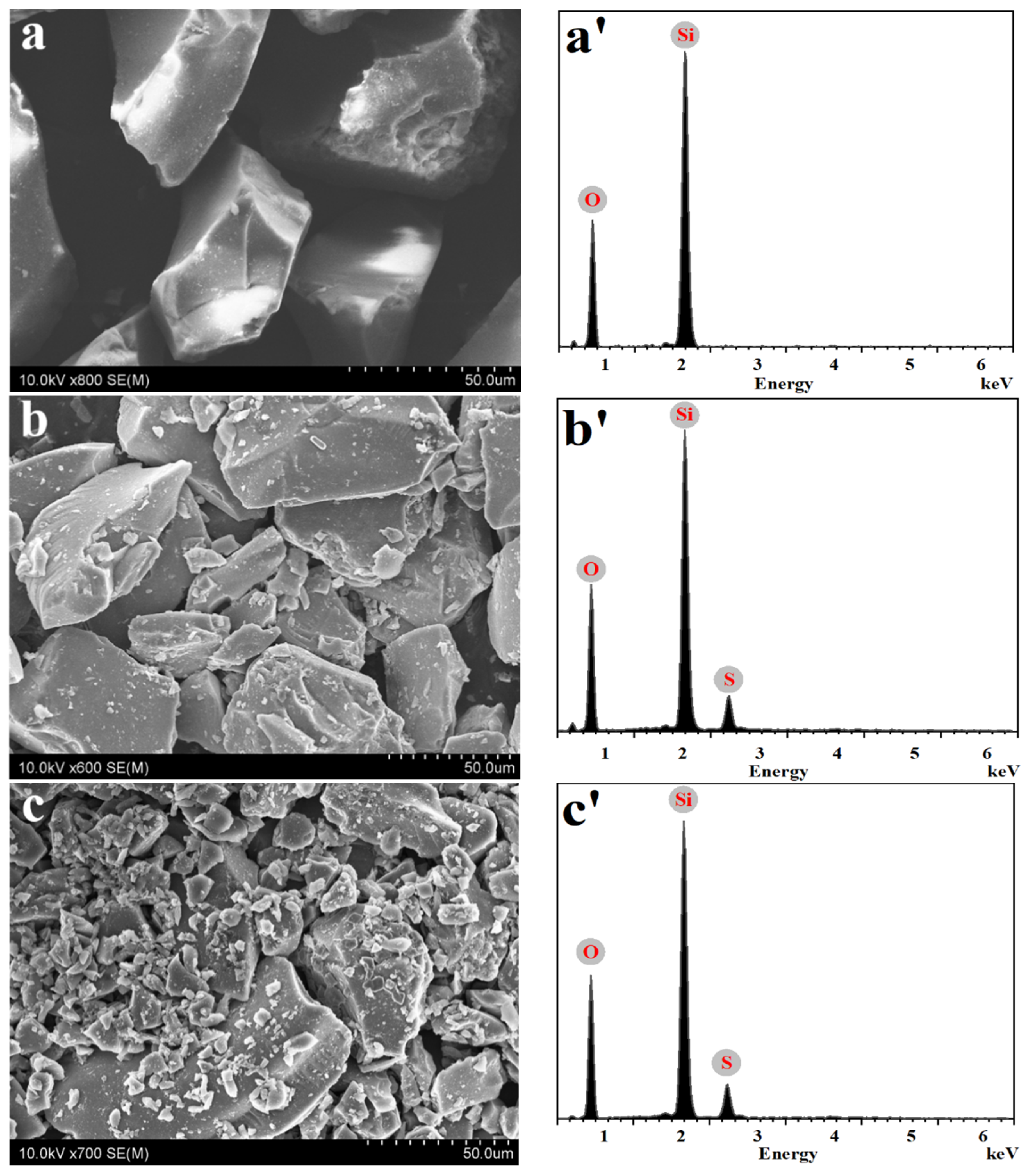
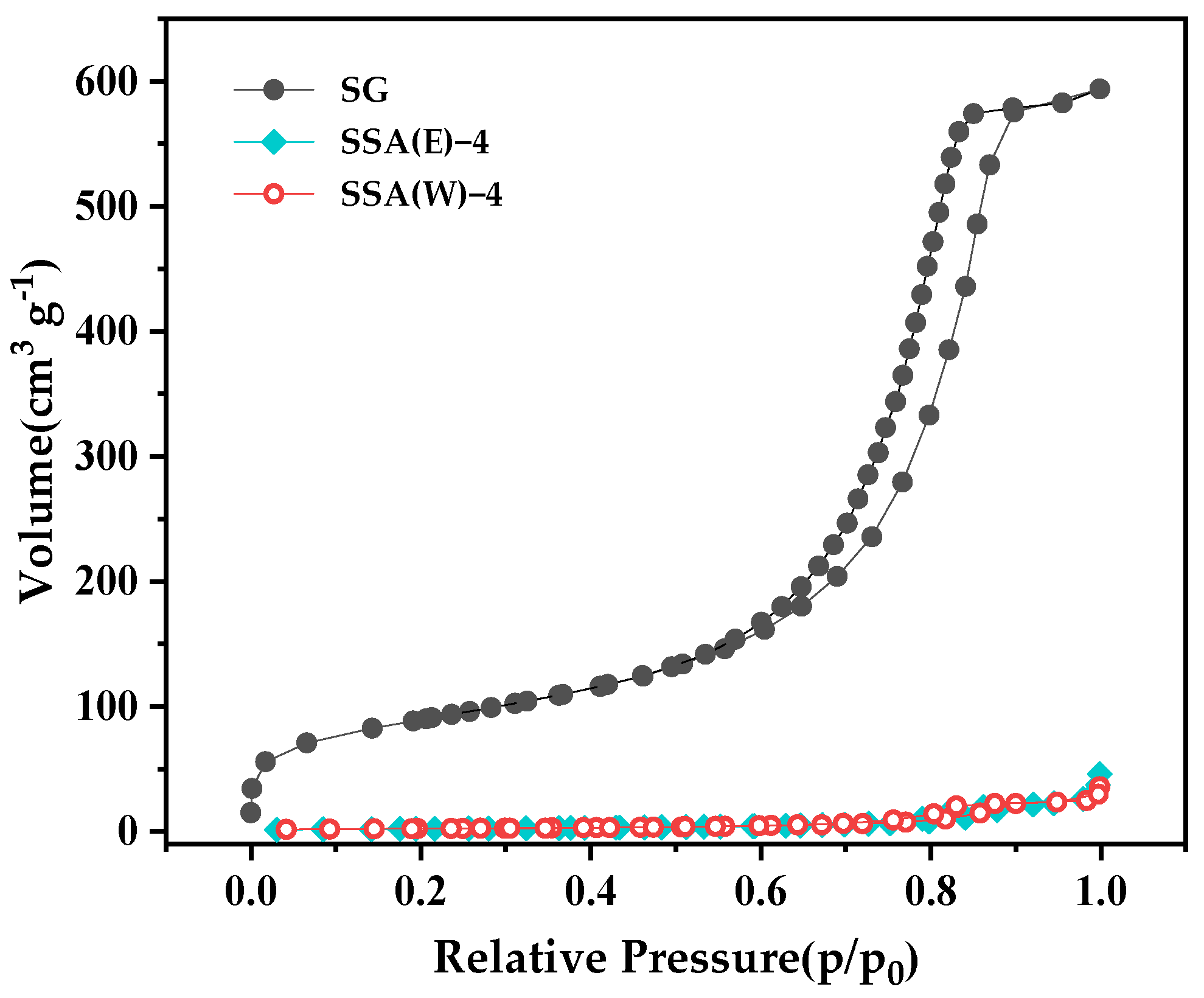
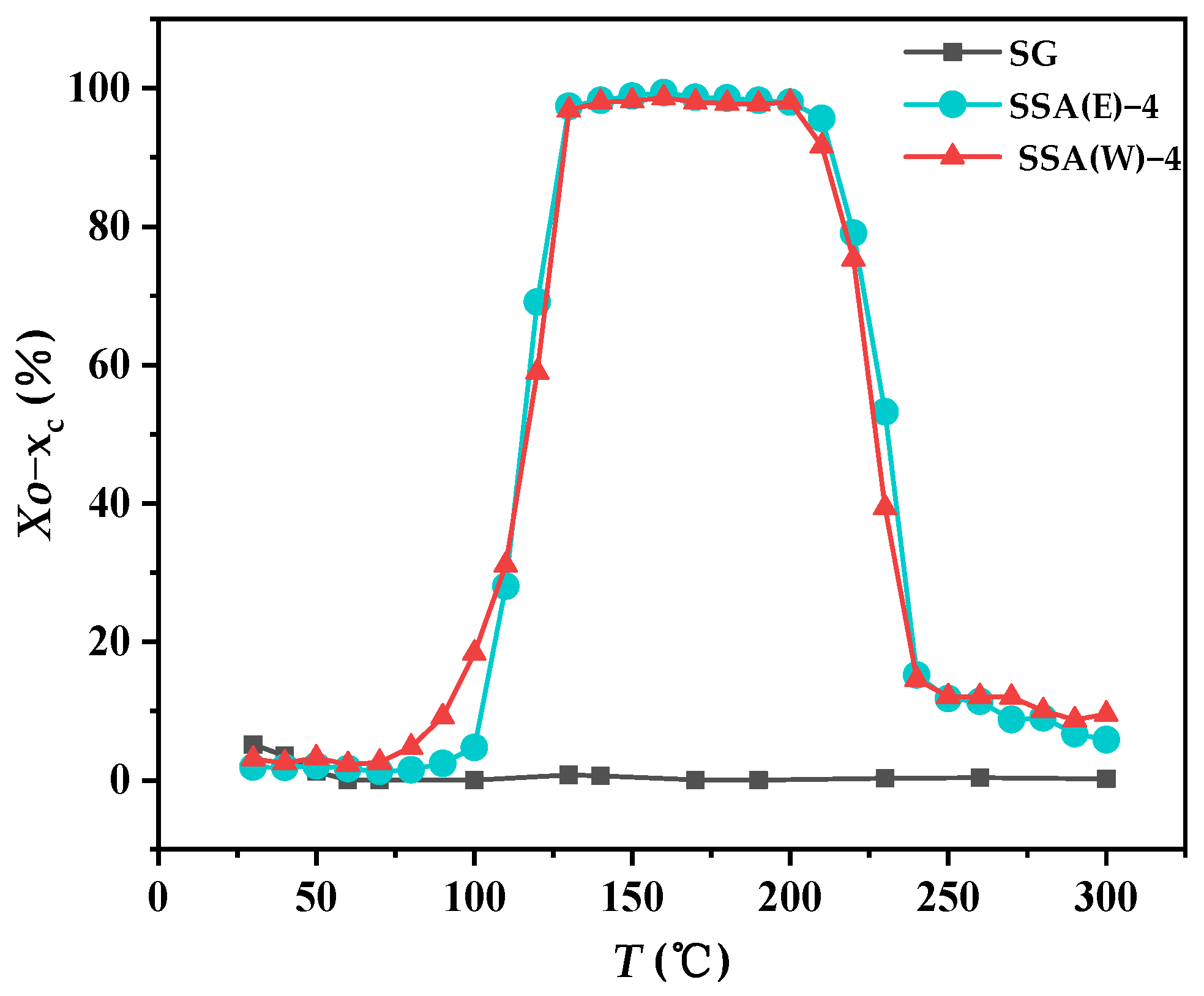

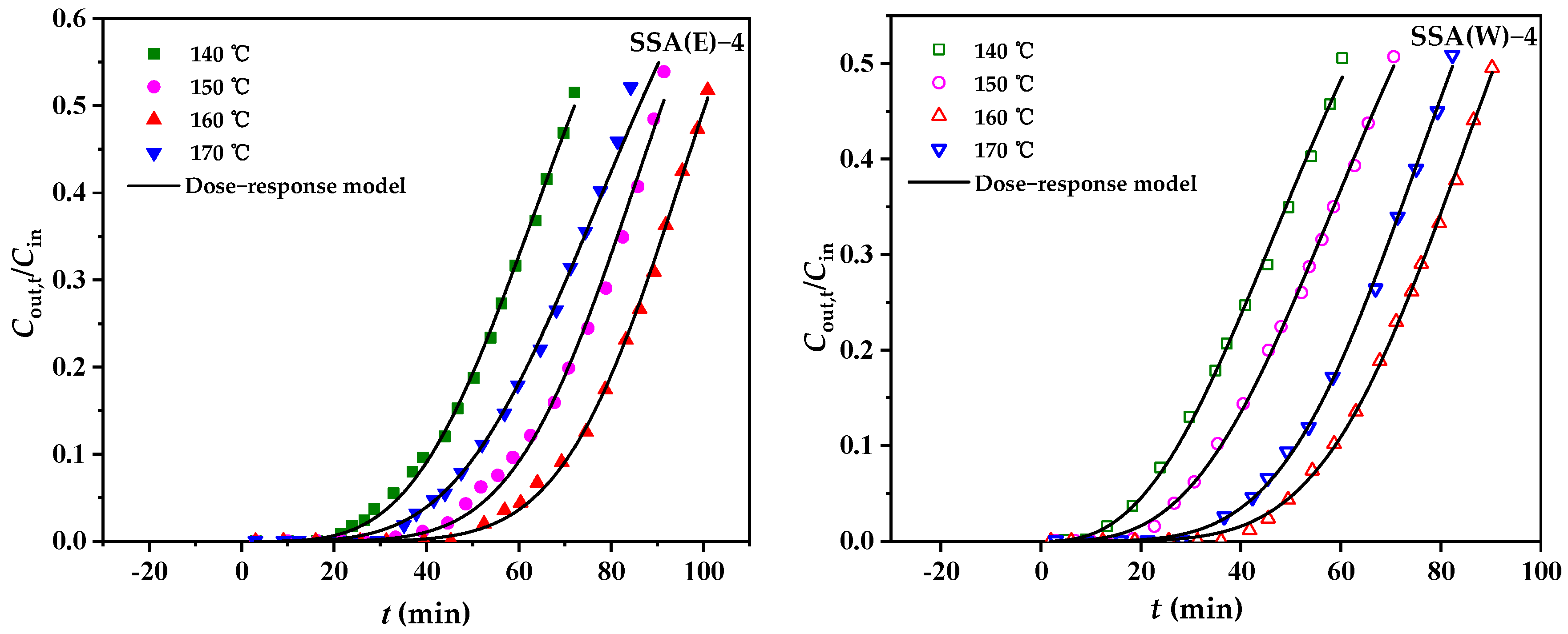
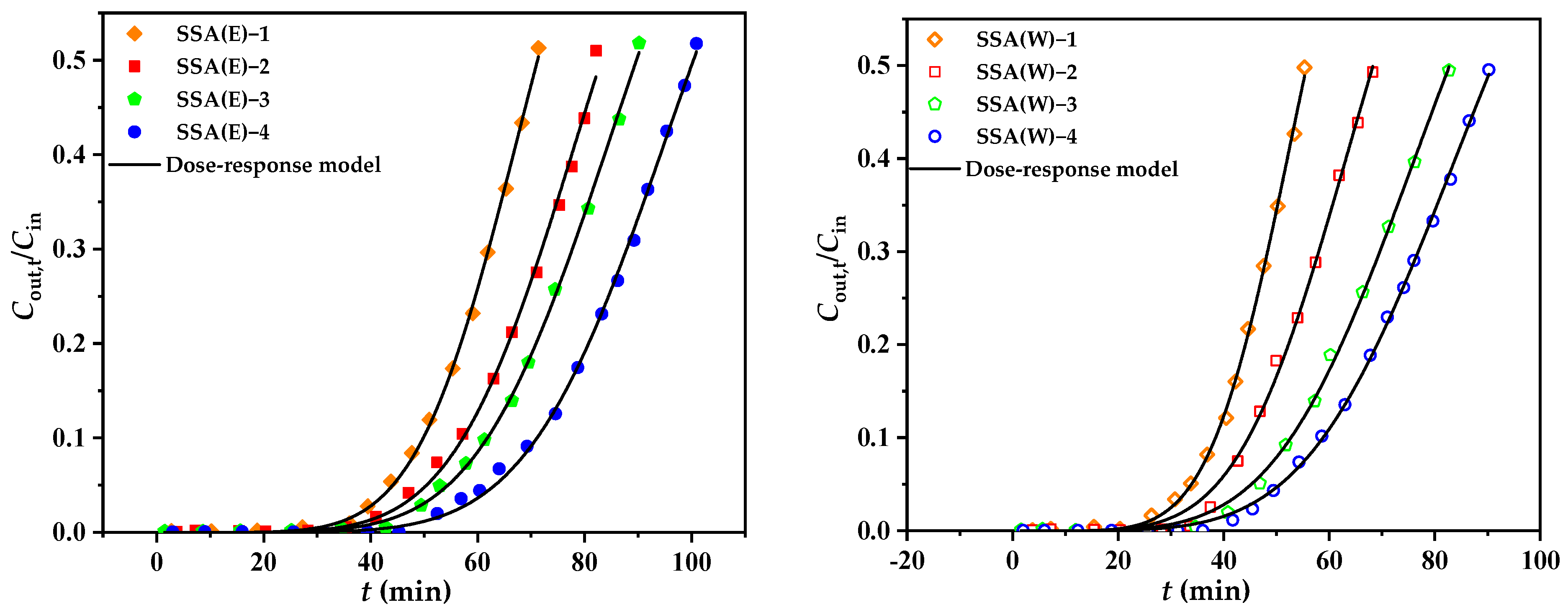
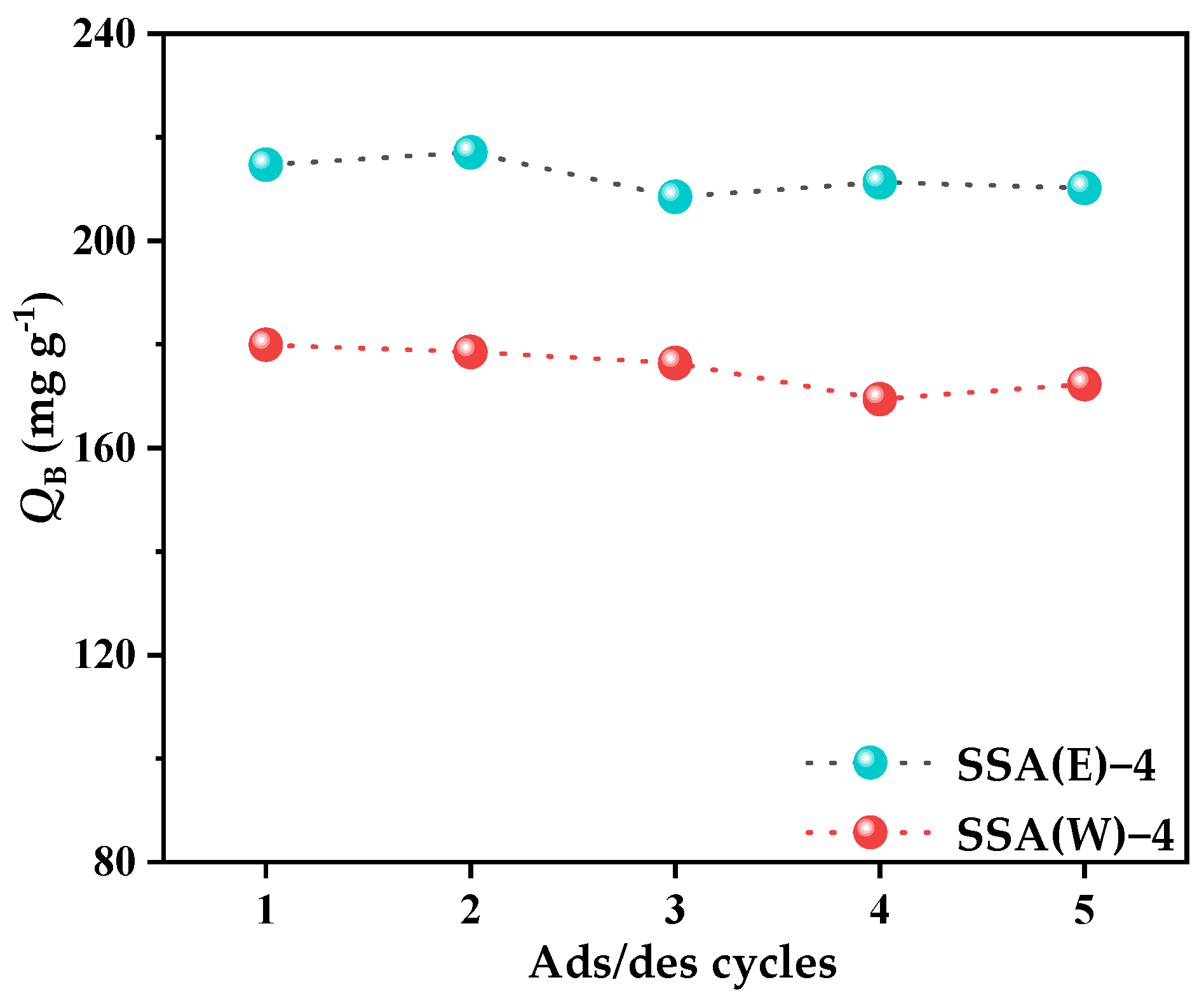
| T (°C) | SSA(E)-4 | SSA(W)-4 | ||
|---|---|---|---|---|
| TG (%) | Sulfuric Acid (%) | TG (%) | Sulfuric Acid (%) | |
| 100–170 (P-state) | −9.7 | 23.8 | −10.2 | 29.8 |
| 170–350 (C-state) | −31.2 | 76.2 | −23.9 | 70.2 |
| T (°C) | 140 | 150 | 160 | 170 | |
|---|---|---|---|---|---|
| SSA(E)-4 | tB (min) | 32.2 | 50.4 | 61.9 | 42.3 |
| QB (mg g−1) | 111.2 | 174.4 | 214.7 | 146.4 | |
| tB,th (min) | 33.9 | 53.3 | 63.2 | 42.5 | |
| QB,th (mg g−1) | 117.6 | 185.2 | 221.0 | 147.6 | |
| q0 (mg g−1) | 0.2523 | 0.3185 | 0.3512 | 0.3012 | |
| a | 3.9182 | 5.1180 | 6.3821 | 4.1696 | |
| R2 | 0.9980 | 0.9944 | 0.9988 | 0.9919 | |
| SSA(W)-4 | tB (min) | 20.4 | 28.4 | 51.9 | 42.9 |
| QB (mg g−1) | 70.0 | 98.1 | 179.9 | 148.3 | |
| tB,th (min) | 20.8 | 28.6 | 50.7 | 43.3 | |
| QB,th (mg g−1) | 72.5 | 99.3 | 176.5 | 149.4 | |
| q0 (mg g−1) | 0.2154 | 0.2478 | 0.3183 | 0.2888 | |
| a | 2.7141 | 3.2536 | 5.0418 | 4.5911 | |
| R2 | 0.9979 | 0.9987 | 0.9992 | 0.9990 | |
| H2SO4 Loading Amount (mmol/g) | 2.8 | 4.0 | 4.8 | 5.6 | |
|---|---|---|---|---|---|
| SSA(E) | tB (min) | 43.5 | 49.0 | 53.7 | 61.9 |
| QB (mg g−1) | 151.1 | 169.8 | 186.5 | 214.7 | |
| tB,th (min) | 44.1 | 50.4 | 54.4 | 63.2 | |
| QB,th (mg g−1) | 154.1 | 174.6 | 188.4 | 221.0 | |
| q0 (mg g−1) | 0.2492 | 0.2908 | 0.3139 | 0.3512 | |
| a | 6.1636 | 5.9063 | 5.9061 | 6.3821 | |
| R2 | 0.9992 | 0.9972 | 0.9991 | 0.9988 | |
| SSA(W) | tB (min) | 33.4 | 40.3 | 46.9 | 51.9 |
| QB (mg g−1) | 115.3 | 140.1 | 162.7 | 179.9 | |
| tB,th (min) | 33.9 | 38.6 | 45.2 | 50.7 | |
| QB,th (mg g−1) | 117.7 | 134.7 | 157.9 | 179.0 | |
| q0 (mg g−1) | 0.1952 | 0.2392 | 0.2899 | 0.3183 | |
| a | 5.9138 | 5.1736 | 4.8660 | 5.0418 | |
| R2 | 0.9990 | 0.9972 | 0.9986 | 0.9992 | |
Publisher’s Note: MDPI stays neutral with regard to jurisdictional claims in published maps and institutional affiliations. |
© 2022 by the authors. Licensee MDPI, Basel, Switzerland. This article is an open access article distributed under the terms and conditions of the Creative Commons Attribution (CC BY) license (https://creativecommons.org/licenses/by/4.0/).
Share and Cite
Zhao, D.; Ma, M.; Qian, J.; Wang, Y.; Ma, Z.; Ma, X. Influence of Impregnation Medium on the Adsorptive Performance of Silica Sulfuric Acid for the Removal of Gaseous o-Xylene: Comparison on Ethyl Acetate and Water. Catalysts 2022, 12, 737. https://doi.org/10.3390/catal12070737
Zhao D, Ma M, Qian J, Wang Y, Ma Z, Ma X. Influence of Impregnation Medium on the Adsorptive Performance of Silica Sulfuric Acid for the Removal of Gaseous o-Xylene: Comparison on Ethyl Acetate and Water. Catalysts. 2022; 12(7):737. https://doi.org/10.3390/catal12070737
Chicago/Turabian StyleZhao, Dandan, Mengze Ma, Jinjin Qian, Yaxu Wang, Zichuan Ma, and Xiaolong Ma. 2022. "Influence of Impregnation Medium on the Adsorptive Performance of Silica Sulfuric Acid for the Removal of Gaseous o-Xylene: Comparison on Ethyl Acetate and Water" Catalysts 12, no. 7: 737. https://doi.org/10.3390/catal12070737
APA StyleZhao, D., Ma, M., Qian, J., Wang, Y., Ma, Z., & Ma, X. (2022). Influence of Impregnation Medium on the Adsorptive Performance of Silica Sulfuric Acid for the Removal of Gaseous o-Xylene: Comparison on Ethyl Acetate and Water. Catalysts, 12(7), 737. https://doi.org/10.3390/catal12070737







